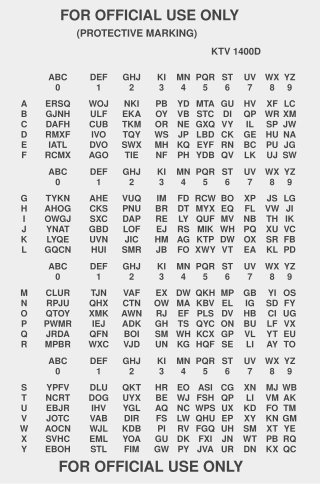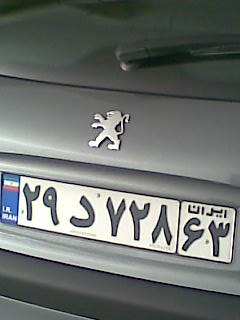Related Research Articles

Morse code is a telecommunications method which encodes text characters as standardized sequences of two different signal durations, called dots and dashes, or dits and dahs. Morse code is named after Samuel Morse, one of the early developers of the system adopted for electrical telegraphy.
In cryptography, a substitution cipher is a method of encrypting in which units of plaintext are replaced with the ciphertext, in a defined manner, with the help of a key; the "units" may be single letters, pairs of letters, triplets of letters, mixtures of the above, and so forth. The receiver deciphers the text by performing the inverse substitution process to extract the original message.

A code talker was a person employed by the military during wartime to use a little-known language as a means of secret communication. The term is most often used for United States service members during the World Wars who used their knowledge of Native American languages as a basis to transmit coded messages. In particular, there were approximately 400 to 500 Native Americans in the United States Marine Corps whose primary job was to transmit secret tactical messages. Code talkers transmitted messages over military telephone or radio communications nets using formally or informally developed codes built upon their Indigenous languages. The code talkers improved the speed of encryption and decryption of communications in front line operations during World War II and are credited with some decisive victories. Their code was never broken.
The International Radiotelephony Spelling Alphabet or simply Radiotelephony Spelling Alphabet, commonly known as the NATO phonetic alphabet, is the most widely used set of clear-code words for communicating the letters of the Roman alphabet. Technically a radiotelephonic spelling alphabet, it goes by various names, including NATO spelling alphabet, ICAO phonetic alphabet and ICAO spelling alphabet. The ITU phonetic alphabet and figure code is a rarely used variant that differs in the code words for digits.

A vehicle registration plate, also known as a number plate or license plate or licence plate, is a metal or plastic plate attached to a motor vehicle or trailer for official identification purposes. All countries require registration plates for road vehicles such as cars, trucks, and motorcycles. Whether they are required for other vehicles, such as bicycles, boats, or tractors, may vary by jurisdiction. The registration identifier is a numeric or alphanumeric ID that uniquely identifies the vehicle or vehicle owner within the issuing region's vehicle register. In some countries, the identifier is unique within the entire country, while in others it is unique within a state or province. Whether the identifier is associated with a vehicle or a person also varies by issuing agency. There are also electronic license plates.
An International Securities Identification Number (ISIN) is a code that uniquely identifies a security globally for the purposes of facilitating clearing, reporting and settlement of trades. Its structure is defined in ISO 6166. The ISIN code is a 12-character alphanumeric code that serves for uniform identification of a security through normalization of the assigned National Number, where one exists, at trading and settlement.
A United States military occupation code, or a military occupational specialty code, is a nine-character code used in the United States Army and United States Marine Corps to identify a specific job. In the United States Air Force, a system of Air Force Specialty Codes (AFSC) is used. In the United States Navy, a system of naval ratings and designators are used along with the Navy Enlisted Classification (NEC) system. A system of ratings is also used in the United States Coast Guard.

In cryptology, a code is a method used to encrypt a message that operates at the level of meaning; that is, words or phrases are converted into something else. A code might transform "change" into "CVGDK" or "cocktail lounge". The U.S. National Security Agency defined a code as "A substitution cryptosystem in which the plaintext elements are primarily words, phrases, or sentences, and the code equivalents typically consist of letters or digits in otherwise meaningless combinations of identical length." A codebook is needed to encrypt, and decrypt the phrases or words.

The DRYAD Numeral Cipher/Authentication System is a simple, paper cryptographic system employed by the U.S. military for authentication and for encryption of short, numerical messages. Each unit with a radio is given a set of matching DRYAD code sheets. A single sheet is valid for a limited time, called a cryptoperiod.

Vehicles registered in Slovakia were generally assigned to one of the districts (okres) and from 1997 until 2022, the license plate coding generally consisted of seven characters and takes the form XX-NNNLL, where XX was a two letter code corresponding to the district, NNN was a three digit number and LL were two additional letters.
Philip Johnston was an American civil engineer who is credited with proposing the idea of using the Navajo language as a Navajo code to be used in the Pacific Theater during World War II.

A telephone exchange name or central office name was a distinguishing and memorable name assigned to a central office. It identified the switching system to which a telephone was connected, and facilitated the connection of telephone calls between switching systems in different localities.
In broadcasting and radio communications, a call sign is a unique identifier for a transmitter station. A call sign can be formally assigned by a government agency, informally adopted by individuals or organizations, or even cryptographically encoded to disguise a station's identity.

As many as 25,000 Native Americans in World War II fought actively: 21,767 in the Army, 1,910 in the Navy, 874 in the Marines, 121 in the Coast Guard, and several hundred Native American women as nurses. These figures included over one-third of all able-bodied Native American men aged 18 to 50, and even included as high as seventy percent of the population of some tribes. The first Native American to be killed in WWII was Henry E. Nolatubby from Oklahoma. He was part of the Marine Detachment serving on the USS Arizona and went down with the ship on December 7, 1941. Unlike African Americans or Asian Americans, Native Americans did not serve in segregated units and served alongside white Americans.
A spelling alphabet is a set of words used to represent the letters of an alphabet in oral communication, especially over a two-way radio or telephone. The words chosen to represent the letters sound sufficiently different from each other to clearly differentiate them. This avoids any confusion that could easily otherwise result from the names of letters that sound similar, except for some small difference easily missed or easily degraded by the imperfect sound quality of the apparatus. For example, in the Latin alphabet, the letters B, P, and D sound similar and could easily be confused, but the words "bravo", "papa" and "delta" sound completely different, making confusion unlikely.
The cipher system that the Uesugi are said to have used is a simple substitution usually known as a Polybius square or "checkerboard." The i-ro-ha alphabet contains forty-eight letters, so a seven-by-seven square is used, with one of the cells left blank. The rows and columns are labeled with a number or a letter. In the table below, the numbers start in the top left, as does the i-ro-ha alphabet. In practice these could start in any corner.

In the United States, all military aircraft display a serial number to identify individual aircraft. These numbers are located on the aircraft tail, so they are sometimes referred to unofficially as "tail numbers". On the Northrop Grumman B-2 Spirit bomber, lacking a tail, the number appears on the nose gear door. Individual agencies have each evolved their own system of serial number identification. Aircraft serials are part of the Aircraft Visual Identification System, which also includes the aircraft's tail code and Modex.

A telephone number is a sequence of digits assigned to a landline telephone subscriber station connected to a telephone line or to a wireless electronic telephony device, such as a radio telephone or a mobile telephone, or to other devices for data transmission via the public switched telephone network (PSTN), or other public and private networks. Modern smart phones have added a built-in layer of abstraction whereby individuals or businesses are saved into a contacts application and the numbers no longer have to be written down or memorized.

BATCO, short for Battle Code, is a hand-held, paper-based encryption system used at a low, front line level in the British Army. It was introduced along with the Clansman combat net radio in the early 1980s and was largely obsolete by 2010 due to the wide deployment of the secure Bowman radios. BATCO consists of a code, contained on a set of vocabulary cards, and cipher sheets for superencryption of the numeric code words. The cipher sheets, which are typically changed daily, also include an authentication table and a radio call sign protection system.

Iranian license plates have had European standard dimensions since 2005. Each province in Iran has multiple unique, two-digit codes that are included at the right end of the license plates in a distinguished square outline, above which the word ایران or "Iran" has been written. A province's license plates will not be issued with a new code unless all possible combinations with the old code have been issued. In Tehran, the first code to be issued for the province was code 11, and subsequent codes all increased by 11 as well Ever since code 99 was fully issued, the new codes for Tehran have started from 10 and subsequently increased by 10. Most province codes increased by 10 based on the first code issued for their province. Khuzestan Province, for example, has been allocated codes 24 and 14, and code 24 will not be used before code 14 is fully issued. However, as codes started getting exhausted, numbers and letters have been assigned more liberally and without following this rule of thumb anymore
References
- Cox, Robert Jon. "Talk Between Ships". The Battle Off Samar: Taffy III at Leyte Gulf. Retrieved 7 October 2020.[ better source needed ]
- ↑ Nez, Chester; Schiess Avila, Judith (2011). Code Talker: The First and Only Memoir By One of the Original Navajo Code Talkers of WWII. Dutton Caliber. ISBN 978-0425244234.